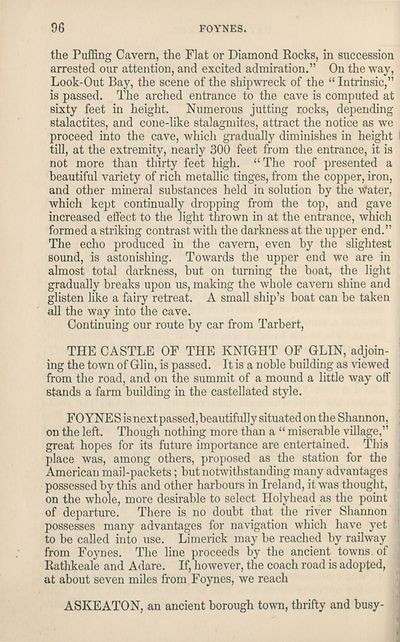Download files
Complete book:
Individual page:
Thumbnail gallery: Grid view | List view

96
FOYNES.
the Puffing Cavern, the Flat or Diamond Rocks, in succession
arrested our attention, and excited admiration.” On the way,
Look-Out Bay, the scene of the shipwreck of the “ Intrinsic,”
is passed. The arched entrance to the cave is computed at
sixty feet in height. Numerous jutting rocks, depending
stalactites, and cone-like stalagmites, attract the notice as we
proceed into the cave, which gradually diminishes in height
till, at the extremity, nearly 300 feet from the entrance, it is
not more than thirty feet high. “The roof presented a
beautiful variety of rich metallic tinges, from the copper, iron,
and other mineral substances held in solution by the Water,
which kept continually dropping from the top, and gave
increased effect to the light thrown in at the entrance, which
formed a striking contrast with the darkness at the upper end.”
The echo produced in the cavern, even by the slightest
sound, is astonishing. Towards the upper end we are in
almost total darkness, but on turning the boat, the light
gradually breaks upon us, making the whole cavern shine and
glisten like a fairy retreat. A small ship’s boat can be taken
all the way into the cave.
Continuing our route by car from Tarbert,
THE CASTLE OF THE KNIGHT OF GLIN, adjoin¬
ing the town of Glin, is passed. It is a noble building as viewed
from the road, and on the summit of a mound a little way off
stands a farm building in the castellated style.
FOYNES is next passed,beautifully situated on the Shannon,
on the left. Though nothing more than a “ miserable village,”
great hopes for its future importance are entertained. This
place was, among others, proposed as the station for the
American mail-packets; but notwithstanding many advantages
possessed by this and other harbours in Ireland, it was thought,
on the whole, more desirable to select Holyhead as the point
of departure. There is no doubt that the river Shannon
possesses many advantages for navigation which have yet
to be called into use. Limerick may be reached by railway
from Foynes. The line proceeds by the ancient towns of
Rathkeale and Adare. If, however, the coach road is adopted,
at about seven miles from Foynes, we reach
ASKEATON, an ancient borough town, thrifty and busy-
FOYNES.
the Puffing Cavern, the Flat or Diamond Rocks, in succession
arrested our attention, and excited admiration.” On the way,
Look-Out Bay, the scene of the shipwreck of the “ Intrinsic,”
is passed. The arched entrance to the cave is computed at
sixty feet in height. Numerous jutting rocks, depending
stalactites, and cone-like stalagmites, attract the notice as we
proceed into the cave, which gradually diminishes in height
till, at the extremity, nearly 300 feet from the entrance, it is
not more than thirty feet high. “The roof presented a
beautiful variety of rich metallic tinges, from the copper, iron,
and other mineral substances held in solution by the Water,
which kept continually dropping from the top, and gave
increased effect to the light thrown in at the entrance, which
formed a striking contrast with the darkness at the upper end.”
The echo produced in the cavern, even by the slightest
sound, is astonishing. Towards the upper end we are in
almost total darkness, but on turning the boat, the light
gradually breaks upon us, making the whole cavern shine and
glisten like a fairy retreat. A small ship’s boat can be taken
all the way into the cave.
Continuing our route by car from Tarbert,
THE CASTLE OF THE KNIGHT OF GLIN, adjoin¬
ing the town of Glin, is passed. It is a noble building as viewed
from the road, and on the summit of a mound a little way off
stands a farm building in the castellated style.
FOYNES is next passed,beautifully situated on the Shannon,
on the left. Though nothing more than a “ miserable village,”
great hopes for its future importance are entertained. This
place was, among others, proposed as the station for the
American mail-packets; but notwithstanding many advantages
possessed by this and other harbours in Ireland, it was thought,
on the whole, more desirable to select Holyhead as the point
of departure. There is no doubt that the river Shannon
possesses many advantages for navigation which have yet
to be called into use. Limerick may be reached by railway
from Foynes. The line proceeds by the ancient towns of
Rathkeale and Adare. If, however, the coach road is adopted,
at about seven miles from Foynes, we reach
ASKEATON, an ancient borough town, thrifty and busy-
Set display mode to:
![]() Universal Viewer |
Universal Viewer | ![]() Mirador |
Large image | Transcription
Mirador |
Large image | Transcription
| Antiquarian books of Scotland > Ireland/Irish > Black's guide to Killarney and the south of Ireland > (108) |
|---|
| Permanent URL | https://digital.nls.uk/118861964 |
|---|
| Description | Thousands of printed books from the Antiquarian Books of Scotland collection which dates from 1641 to the 1980s. The collection consists of 14,800 books which were published in Scotland or have a Scottish connection, e.g. through the author, printer or owner. Subjects covered include sport, education, diseases, adventure, occupations, Jacobites, politics and religion. Among the 29 languages represented are English, Gaelic, Italian, French, Russian and Swedish. |
|---|

